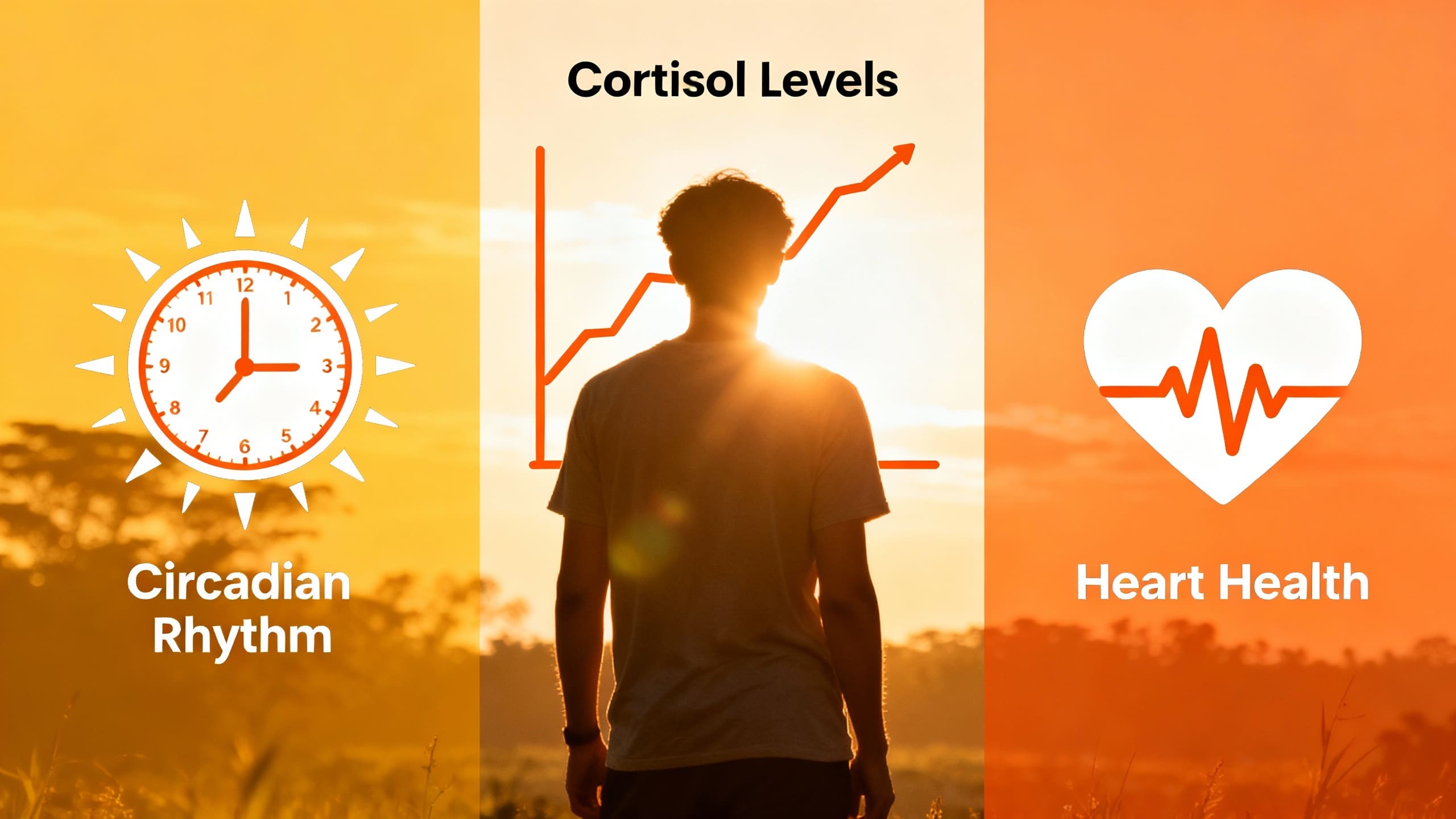Introduction
Early exposure to natural morning light plays a crucial role in aligning the circadian rhythm—the body’s internal clock—with the external environment. This synchronization has profound impacts on heart health, sleep quality, cortisol regulation, and blood pressure, all of which contribute to achieving an optimal heart. By making small lifestyle changes, such as getting sunlight early in the day, individuals can experience improved cardiovascular outcomes and preventative benefits for heart disease. This article explores the science and practical applications behind the benefits of early light exposure for an optimal heart.
What is Early Light Exposure?
Early light exposure refers to receiving natural sunlight shortly after waking, typically within the first hour of the day. This practice is deeply rooted in the biology of the circadian rhythm, which governs sleep-wake cycles and many metabolic processes, including those essential for heart health. Morning light is especially powerful because it signals to the brain’s suprachiasmatic nucleus (SCN) to reset the circadian rhythm, leading to timely cortisol release and influencing blood pressure regulation (Lucas, 2014, McHill & Wright, 2017).
Benefits and Outcomes in Heart Disease
Evidence suggests that early light exposure supports cardiovascular health through several mechanisms:
- Cortisol Timing: Exposure to morning light helps trigger the cortisol awakening response at the right time, avoiding late spikes linked to hypertension and increased heart disease risk (Wright et al., 2013).
- Blood Pressure Regulation: Morning light aligns circadian rhythms, supporting natural drops in blood pressure during sleep and healthy rises in the morning, which are vital for optimal heart health (Scheer et al., 2009).
- Sleep Quality: Consistent exposure to early sunlight improves sleep latency and duration, factors associated with lower cardiovascular risk (Reid & Zee, 2009).
- Reduced Inflammation: Proper circadian alignment via light exposure may lower systemic inflammation, further benefiting the heart (Cederroth et al., 2019).
- Prevention of Metabolic Dysfunction: Since the circadian system regulates metabolism, improved alignment can reduce the risk of obesity and diabetes—major heart disease risk factors (Depner et al., 2019).
Research Insights
Recent studies highlight that individuals who regularly receive early morning natural light experience:
- Improved blood pressure profiles and better 24-hour blood pressure variability, essential for an optimal heart (Mulder et al., 2018).
- A more robust and timely cortisol awakening response, connected to reduced cardiovascular risk (Wright et al., 2013).
- Enhanced sleep efficiency, lowering risk for arrhythmias and other negative heart outcomes (Reid & Zee, 2009).
- Reductions in heart rate and inflammatory biomarkers when circadian rhythm is optimized through morning light (Cederroth et al., 2019).
- Clinical guidelines recommend circadian-friendly routines, including morning light exposure, as part of comprehensive heart disease prevention (Arendts & Quast, 2023).
Practical Applications
Incorporating early light exposure into daily life can be simple and effective:
- Natural Sunlight: Aim to spend 15–30 minutes outside shortly after waking, before 9am if possible (Lucas, 2014).
- Positioning: Sit near an east-facing window or go for a light walk in the morning.
- Light Therapy Lamps: In winter or for shift workers, specially designed lamps (2,000–10,000 lux) can mimic natural sunlight (Reid & Zee, 2009).
- Populations Who Benefit Most: Older adults, individuals with metabolic syndrome, people with hypertension, or anyone who struggles with sleep may see pronounced cardiovascular gains (Scheer et al., 2009).
Safe exposure limits are generally 15–30 minutes per day, avoiding direct midday sunlight to protect skin.
Risks & Limitations
While early light exposure is generally safe, some considerations include:
- Photosensitivity: People taking certain medications or with specific skin conditions may need to protect skin (Depner et al., 2019).
- Limited Research in Disease States: While healthy adults benefit, more research is needed for those with existing heart disease or severe sleep disorders (Arendts & Quast, 2023).
- Seasonal Variation: Sunlight intensity changes seasonally and with latitude, which can affect routine consistency (Lucas, 2014).
Key Takeaways
- Morning light exposure supports circadian rhythm alignment—essential for Heart Health and achieving an Optimal Heart.
- Early sun exposure aids in proper cortisol timing, healthy blood pressure patterns, and restful sleep.
- Scientific evidence links early light with reduced inflammation and better cardiovascular outcomes.
- Simple routine adjustments can have outsized benefits for heart disease prevention.
Frequently Asked Questions
Is early light exposure really important for Heart Health?
Yes. Studies show that early morning light synchronizes the circadian rhythm, supporting optimal heart function and lowering cardiovascular risk (Lucas, 2014).
How much early sunlight do I need for benefits?
Generally, 15–30 minutes each morning is sufficient to support an optimal heart and establish stable circadian rhythms (Reid & Zee, 2009).
Can artificial light replace natural morning sunlight?
Light therapy lamps can be helpful during winter or for shift workers to maintain heart health when sunlight is scarce (Reid & Zee, 2009).
Does this help people who already have heart disease?
Preliminary evidence suggests benefits, but more research is needed for specific recommendations in patients with established heart conditions (Arendts & Quast, 2023).
Suggested Links
- American Heart Association: Sleep and Heart Health
- National Institutes of Health: Circadian Rhythms
- PubMed: Research on Light Exposure and Cardiovascular Health
Conclusion
Embracing early morning light can be a simple, powerful way to enhance your heart health and work toward an optimal heart. By integrating this practice into your routine, you align your body’s natural rhythms, encourage healthy blood pressure and cortisol levels, and set yourself up for restful sleep and long-term cardiovascular benefits. Consider stepping outside for sunlight as your first step to a healthier heart—and consult your doctor before making significant lifestyle changes, especially if you have existing heart conditions.



